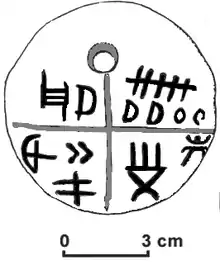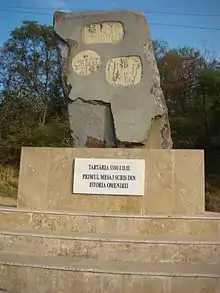Tontafeln von Tărtăria
Die Tontafeln von Tărtăria sind drei kleine Tontafeln (möglicherweise Amulette), die im Jahre 1961 in der Ortschaft Tărtăria entdeckt wurden, die heute ein Teil der Gemeinde Săliștea (Kreis Alba) in Rumänien ist. Sie zeigen Vinča-Zeichen, die wichtigste regionale Variante des Donauschrift genannten Zeichensystems, das auch als alteuropäische Schrift bezeichnet wird (auch wenn die Einordnung des Zeichensystems als Schrift umstritten ist). Die Zeichen werden der prähistorischen Vinča-Kultur zugeordnet. Die Tontafeln werden auf etwa 5500–5300 v. Chr. datiert,[1] wurden jüngst allerdings als mögliche Fälschung bezeichnet.[2] Sie werden im Muzeul Național de Istorie a Transilvaniei (Nationalmuseum der Geschichte Siebenbürgens) in Cluj-Napoca (Klausenburg) verwahrt.[3]


Die Entdeckung
1875 entdeckten Archäologen bei Ausgrabungen in Turdaș viele Gegenstände mit bisher unbekannten Symbolen. 1961 entdeckte eine Forschergruppe des Nationalmuseums in Cluj unter der Leitung von Nicolae Vlassa die drei hier beschriebenen Tontafeln.[4]
Einer 2013 veröffentlichten These zufolge könnten die Tontafeln von Tărtăria eine Fälschung sein.[2]
Literatur
- A. Falkenstein: Zu den Tafeln aus Tartaria, in: Germania 43 (1965) 269–273.
- Harald Haarmann: Writing from Old Europe to Ancient Crete - A Case Study of Cultural Continuity, in: The Journal of Indo-European Studies 17 (1990) 251-277.
- Dominique Jongbloed: Civilisations antédiluviennes. Bilan de 2.500 ans de recherches, Alphée ed. 2011.
- Gheorghe Lazarovici, Fl. Drasovean & Z. Maxim 2000 The Eagle – the Bird of death, regeneration resurection and messenger of Gods. Archaeological and ethnological problems. Tibiscum, 57–68
- Gheorghe Lazarovici, Fl. Drasovean & Z. Maxim 2000 The eye – symbol, gesture, expresion.Tibiscum, 115–128
- Gheorghe Lazarovici, Marco Merlini: New archaeological data referring to Tărtăria tablets, in: Documenta Praehistorica XXXII, Department of Archeology Faculty of Arts, University of Ljubljana, Ljubljana 2005, S. 205–219 (online, PDF).
- Marco Marlini: La scrittura è natta in Europa?, Roma 2004.
- Marco Merlini: The Sacred Cryptograms from Tărtăria. Unique or Widespread Signs? Putting the Asserted Literate Content of the Tablets under Scrutiny, in: Fifty Years of Tărtăria Excavations. Festschrift in Honor of Gheorghe Lazarovici, Sebastopol/Kalifornien 2014, S. 73–119.
- Janos Makkay: The Late Neolithic Tordos Group of Signs. Alba Regia 10 (1969) 9–50.
- Janos Makkay: Early Stamp Seals in South-East Europe. Budapest 1984.
- Emilia Masson: L' écriture dans les civilisations danubiennes néolithiques. Kadmos 23,2 (1984) 89-–123.
- Zoia Maxim: Neo-eneoliticul din Transilvania. Bibliotheca Musei Napocensis 19. Cluj-Napoca 1997.
- Marco Marlini, Gheorghe Lazarovici: Settling discovery circumstances, dating and utilization of the Tărtăria tablets (PDF; 10,8 MB). In: Acta Terrae Septemcastrensis. Band: VII. 2008. Lucian Blaga University of Sibiu.
- Vladimir Milojčić: Die Tontafeln von Tartaria (Siebenbürgen), und die Absolute Chronologie des mitteleuropäischen Neolithikums, in: Germania 43 (1963) 266–268.
- Iuliu Paul: Vorgeschichtliche untersuchungen in Siebenburgen. Alba Iulia 1918 (Inhaltsverzeichnis online).
- Nicolae Vlassa: Contribuții la Problema racordării Neoliticul Transilvaniei, 1976, S. 28–43, fig. 7–8.
- Winn Milton McChesney: The signs of the Vinc̆a Culture, University Microfilms, 1973.
- Shan M. Stroemfeld Winn: Pre-writing in Southeast Europe: The Sign System of the Vinča culture. BAR 1981.
Weblinks
Einzelnachweise
- Harald Haarmann: "Geschichte der Schrift", C.H. Beck, 2002, ISBN 3-406-47998-7, S. 20.
- Erika Qasim: Die Tărtăria-Täfelchen – eine Neubewertung. In: Das Altertum, ISSN 0002-6646, Bd. 58, 4 (2013), S. 307–318.
- Photos from Romania – The Tartaria tablets. www.romaniaphotos.ro, abgerufen am 29. März 2015 (englisch).
- Alasdair W. R. Whittle, Europe in the Neolithic: The Creation of New Worlds, Cambridge University Press, 1996, S. 101.